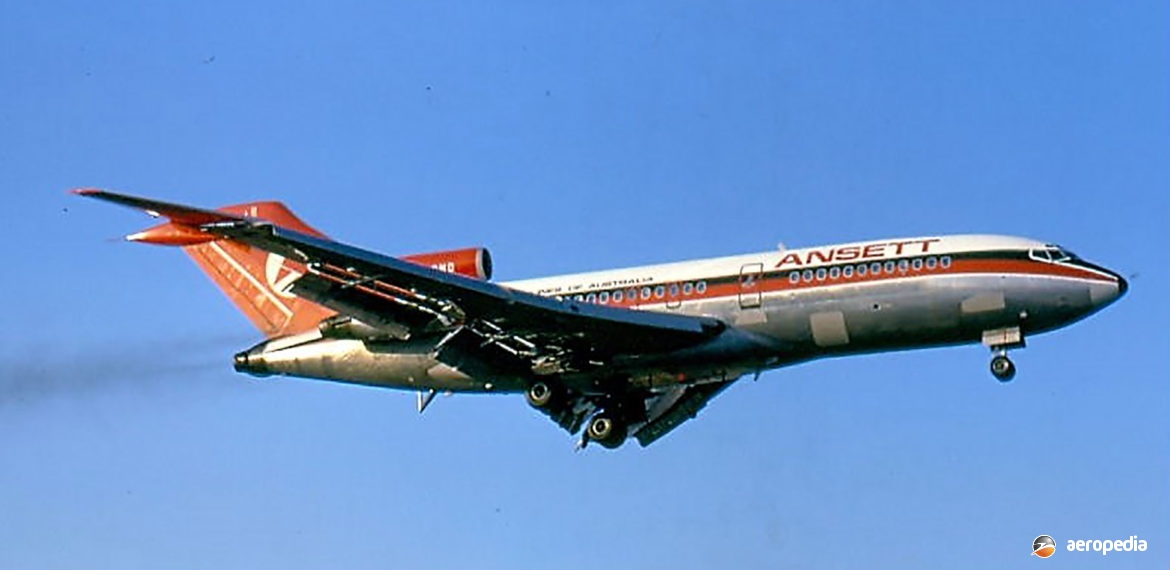Photograph:
Boeing 727-77 VH-RMD (c/n 18844) at Tullamarine, VIC in July 1979 (David C Eyre)
Country of origin:
United States of America
Description:
Commercial transport
Power Plant:
Three 14,000 lbst Pratt & Whitney JT8D-1 turbofans
Specifications:
- Wingspan: 32.92 m (108 ft)
- Length: 40.59 m (133 ft 2 in)
- Height: 10.36 m (33 ft 9 in)
- Wing area: 157.9 m² (1,700 sq ft)
- Max speed at 6,797 m (22,300 ft): 1,013 km/h (629 mph)
- Max cruising speed: 960 km/h (597 mph)
- Economical cruising speed: 917 km/h (570 mph)
- Initial rate of climb: 896 m/min (2,940 ft/min)
- Service ceiling: 11,003 m (36,100 ft)
- Range with max payload: 5,000 km (3,107 miles)
- Empty weight: 36,560 kg (80,602 lb)
- Loaded weight: 72,570 kg (160,000 lb)
History:
One of the best selling jet airliners of all time, the Boeing 727 series had sold 1,832 examples when production ceased in 1984. The Model 727 was initially designed as a medium to short range airliner for airlines which required the passenger carrying capability but not the long-range of the Model 707. Retaining some features in common with the Model 707 was one of the design objectives in order to achieve economy. Eventually it was decided to have a three-engine layout with Pratt & Whitney JT8D turbojets. In order to achieve some short-field performance, high-lift devices were adopted on the wings, and these included leading-edge slats and flaps, and triple-slotted trailing-edge flaps.
The new Model 727 was launched in December 1960 when United Airlines and Eastern Airlines, both in the United States, showed confidence in the design by ordering 40 aircraft each. The prototype, the Model 727-100 (N7001U) with accommodation for up to 125 passengers, flew for the first time on 9 February 1963 at Seattle, Washington and the type entered service with Eastern Airlines in February of the following year. Type approval was granted on 24 December 1963.
As sales increased, Boeing offered a number of variants to meet customer requirements. At first these were primarily concerned with fuel capacity and higher operating weights. Progressive increases were made in engine power as engines were developed.
In July 1964 the Model 727C was announced. A convertible passenger/cargo version, it had a side-loading freight door and cargo-handling system. A further development was the Model 727QC (quick change) which first entered service in May 1966. This model had the passenger seats and galleys on pallets to achieve quick conversion to freight configuration. On 14 August 1984 Boeing 727-2S2F (N217FE) was rolled out, being the last Model 727 completed.
First of the series seen in this region was N7003U (c/n 18295), a Model 727-22, which arrived on 29 September 1963, this being a Boeing demonstrator making a world demonstration tour. Both Ansett and TAA were interested in obtaining the 727 series but the range to fly from Sydney, NSW to Perth, WA was not available until Boeing increased the gross weight by 3,629 kg (8,000 lb) and increased fuel capacity to 29,069 litres (6,394 Imp gals), fitted a Collins Flight Director, additional escape hatches which permitted an increase in passenger accommodation from 109 to 135, and larger mainwheel tyres. TAA initially ordered two on 9 February 1963.
The first two Australian machines were VH-RME and VH-TJA which both arrived at Essendon airport, Melbourne, VIC on 16 October 1964. The 727 series was purchased by Australia’s two internal airlines, TAA (later Australian Airlines), and Ansett. TAA obtained six Model 727-76s VH-TJA (c/n 18741 – ‘James Cook’), VH-TJB (c/n 18742 – ‘John Forrest’), VH-TJC (c/n 18843 – ‘Arthur Phillip’), VH-TJD (c/n 19254 – ‘Gregory Blaxland’), VH-TJE (c/n 20228 – ‘Matthew Flinders’), and VH-TJF (c/n 20371 – ‘William Dampier’), these aircraft later being painted in Australian Airlines colours.
Ansett obtained six 727-77s including VH-RMD (c/n 18844), VH-RME (c/n 18743), VH-RMF (c/n 18744), and VH-RMR (c/n 19253); Model 727-77C VH-RMS (c/n 20278) and Model 727-77QC VH-RMT (c/n 20370). These entered service in September 1964 and continued until they were replaced by later 727 models. They were sold overseas, mainly to International Air Leases of Miami, Florida, and were leased to other airlines. The last was retired from Australian service in mid 1980. Two were exported to Air Nauru, VH-RMS becoming C2-RN7 and VH-RMT becoming C2-RN4.
After retirement from airline service a number were operated in Australia on other work. Bloodstock Air Services operated a Model 727-25F VH-LAP (c/n 18270 – ex N8119N – ‘Phar Lap’) from April 1983, this aircraft later being obtained by Ansett Industries.
The New Zealand Government obtained three ex-United Airlines Model 727-22Cs in 1981, the intention being to use two in the VIP role and the third for spares, the latter being NZ7273 (c/n 19893 – ex N7436U), flown to RNZAF Woodbourne on 25 June 1981, having logged 21 hours with the RNZAF, and was broken up there for spares.
The two which were placed in service with the RNZAF NZ7271 (c/n 19892 – ex N7435U) and NZ7272 (c/n 19895 – ex N7438U) were also used for freight work and moving troops to exercises in Singapore, Australia and the South Pacific region. In 2003 they were retired from service, being replaced by two Boeing 757s.
NZ7271, which had originally been operated by United Airlines, was offered for sale, being obtained by NZ Aircraft Trading Ltd late in 2003 and eventually ended up in Swaziland in South Africa where it operated for some years as 3D-KMJ. NZ7272 became an engineering training airframe at RNZAF Base Woodbourne, being delivered there on 25 August 2003.
In the United States Dee Howard up-graded early Model 727-100s for freight work for United Parcel Service (UPS), and this involved the installation of Rolls Royce Tay engines, these reducing specific fuel consumption, but also permitting the aircraft to meet Stage 3 noise requirements. In addition Valsan and a number of other companies converted a number to Quiet 727 standard, fitting Hushkits, etc, to permit them to meet airport requirements.

